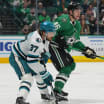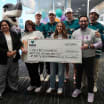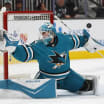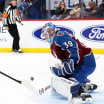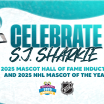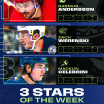There are many paths to the NHL. Today, the most common involves developing at the AHL level before advancing to the National Hockey League. Until 2001, when the AHL and IHL merged, playing in the International Hockey League (IHL) was another prominent route for players to reach the NHL.
In 1991, during the San Jose Sharks' inaugural season, the first, and second Black players to suit up for the Sharks, Dale Craigwell and Mike McHugh, both came to the Sharks via the IHL.
Paving the Way for Future Generations of Black Hockey Players
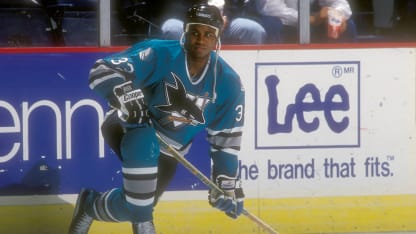
By
Ian Kennedy
Historically, however, the racism and systemic barriers Black hockey players faced to compete professionally were nearly insurmountable.
Forty-five years before McHugh and Craigwell joined the San Jose Sharks, and twelve years before Willie O'Ree broke the NHL's color barrier in 1958, another Black hockey player, Wilfred 'Boomer' Harding was paving the way for future generations.
Harding got his start in sport playing baseball for the Chatham Coloured All-Stars, who in 1934 became the first and only all-Black team in Canadian history to win a provincial title.
On the field, Harding and the All-Stars were bombarded with stones, spit, and racist slurs during games. When they won, the team often had to fight their way out of town. During their 1934 title run, on-field bias attempted to thwart their success.
In the deciding game of their fated run, with the All-Stars leading 3-2 late, umpires called the game in broad daylight, citing "darkness" as the reason. Officials decided to revert the score to a 2-2 tie, temporarily robbing the All-Stars of their title.
"There was no way we were going to win that game," recalled Harding years later.
"Why'd they call the game on account of darkness?" questioned Harding's son Blake. "Well it was dark because there were nine Black players out there, that's why it was too dark."
The game was rescheduled, and new umpires were hired. When the rematch took place, Harding and the All-Stars left no question about the result, winning the championship game 13-7.
Each Fall, as temperatures dropped, Harding traded in his bat for a hockey stick. He'd skate on an outdoor rink created on the Chatham Coloured All-Stars home field. For Black people at the time, skating was restricted to outdoor rinks as indoor facilities were for "whites only."
It soon became clear that Harding was not just a great baseball player, he was destined to be a great hockey player as well.
When World War II broke out, Harding enlisted and soon began playing hockey for military teams, both on Canadian soil, and in Europe.
His talent was immediately evident, earning him an invitation to play for a Canadian Armed Forces all-star team. Upon the conclusion of the way, they toured Europe playing professional clubs at each stop. The team featured NHL players from the New York Rangers, Montreal Canadiens, Detroit Red Wings, and Harding.
On this team, Harding struck up a friendship with Red Wings forward Adam Brown. Nicknamed "The Flying Dutchman," Brown was only two years removed from winning the 1942-43 Stanley Cup. Upon returning to North America, Brown recommended Harding to the Red Wings, landing him a spot with their IHL affiliate, the Windsor Staffords.
In 1946, Wilfred 'Boomer' Harding joined the Staffords, becoming the first-ever Black person to play in the IHL.
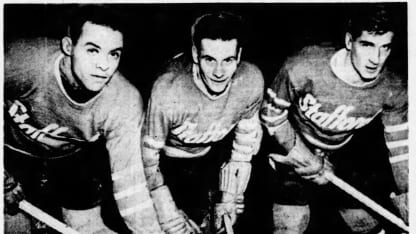
Before the season was over, Harding would break another barrier. He became the first Black person to play hockey at Detroit's Olympia Stadium, home of the Red Wings at the time.
For Harding, hearing his blades cut across the ice at Olympia was redemption. Only two years prior, Boomer and his siblings were turned away steps from the ice. According to the arena attendant, public skating at Olympia Stadium was for white guests only.
Even though Boomer Harding was now on the ice at Olympia, and on the roster with Windsor, the racism he faced for being the only Black player on his team and in the league continued.

Boomer could see the NHL, but he was Black, and the NHL was not ready for a Black athlete.
At the time, the Windsor Staffords owner promised to buy any player scoring a hat trick a fedora to proudly wear to games. In one of his first games, Harding quickly scored a pair of goals in the first period. A third goal, however, would not come, because Harding would not step back on the ice. His coach benched him without a word. A few games later, it happened again. Harding scored two early goals, but instead of continuing to ride one of their top players, Harding was benched. Harding soon realized he would never score a hat trick, and his goal of playing in the NHL was only a dream.
To stay in games, Harding abandoned attempts to score early. He would pass off the puck in every situation, and focus on defence. When the third period arrived, Harding took his chances to score. That way if he was benched, he'd only miss a portion of the final frame.
Harding finished his lone season in IHL collecting 20 points in 25 games, despite being regularly benched for scoring.
As Harding's son Blake said, the white ice of the 1940s was a lonely place for a Black man.
"It was that feeling of maybe, Jackie Robinson, that I'm out here all by myself, there's nothing I can do to hide it. I'd take my helmet off -- well, they didn't wear helmets -- so a Black man on white ice sticks out. And back then it really stuck out."
After Harding, it took 11 years for another Black player to compete at Olympia Stadium when Johnny Utendale skated for the Western Hockey League's Edmonton Flyers.
Art Dorrington, the first Black player to sign an NHL contract, inking with the New York Rangers in 1950, was the next prominent Black player in the IHL making his debut for the Johnstown Jets in 1953-54. Dorrington, like Harding however, was not admitted by hockey's gatekeepers to the NHL.
Without Boomer Harding, the door to the IHL, and NHL may have remained closed for future Black players including Dorrington and Willie O'Ree, as well as San Jose Sharks groundbreakers Mike McHugh and Dale Craigwell.
Craigwell was a 10th round selection of the Sharks in the 1991 NHL draft. He made his professional debut that year with the IHL's Kansas City Blades before earning a call up to the Sharks, becoming the first Black player in franchise history. In total, Craigwell played 98 games in the NHL, all with the San Jose Sharks, collecting 28 points. At the IHL level, he appeared in 412 games scoring 304 points. Before joining the Sharks, McHugh spent three seasons with the IHL's Kalamazoo Wings, making his NHL debut in 1988 with the Minnesota North Stars. In 1991-92, McHugh scored his first and only NHL goal while wearing a Sharks jersey.
Despite joining the NHL when they did, McHugh and Craigwell were respectively only the 16th and 19th Black players in NHL history.
Boomer Harding was denied entry to the NHL, but he knew why. It wasn't for a lack of talent or passion for the game. Whenever he was asked why he didn't make the NHL, Harding would quietly respond the same way. Silently, he'd look down and rub the skin on his arms.
Although his NHL dreams were unfulfilled, his impact on the game remains.
A resident of Erie Beach, Ontario, Ian Kennedy is an educator and journalist with a passion for storytelling. The founder of the Chatham-Kent Sports Network, Ian is a contributor for The Hockey News and Outdoor Canada. Ian's debut novel, "On Account of Darkness: Shining Light on Race and Sport" will be published in May 2022 by Tidewater Press, and is available for pre-order now.

